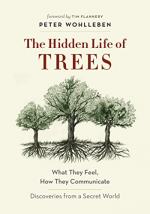|
This section contains 1,606 words (approx. 5 pages at 400 words per page) |

|
Summary
Chapter 19
Wohlleben argues that the representation of nature as a careful balance of organisms doing things that are good for everybody is false. He says the forest creatures are ruthless and limited by availability. Woodpeckers have flexible beaks and shock-absorbing muscles that let them peck holes into trunks, out of which the trees’ blood flows, which the peckers eat. Aphids attach themselves to leaf and needle veins, letting the sap flow through them, filtering out the protein, and expelling the carbohydrates as a sticky liquid. The trees defend themselves against ‘sap-suckers’ and resulting infections by releasing defensive compounds and forming a thick outer layer of bark. Aphids benefit other organisms though, such as ladybugs, ants, bees, fungi, and bacteria who eat the aphids and their honeydew. Gall midges and wasps lay their eggs inside leaves, the larvae release chemicals that harden the leaf...
(read more from the Chapters 19-24 Summary)
|
This section contains 1,606 words (approx. 5 pages at 400 words per page) |

|




